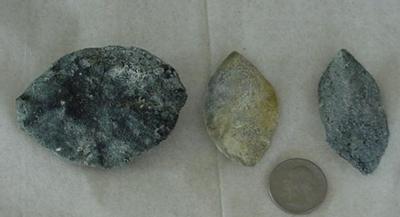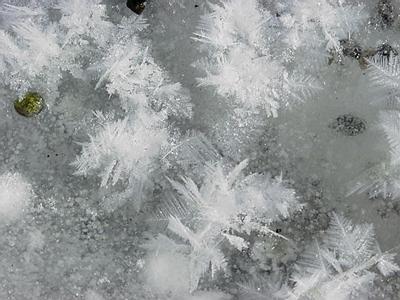13 December, 1999
Crystal day at the mountain.
When many liquids turn into solids, the parcticles (atoms, molecules, or
ions) arrange themselves in an orderly pattern, much like oranges in a
packing crate. Based on the type, and size of the parcticles, the
arrangement varies to form solids (crystals) of different shapes. The most
common liquid to solid formation is liquid water turning to ice. You have
perhaps seen ice crystals on the inside of your freezer, and noticed their
beautiful shapes, or seen pictures of snowflakes.

1. On this day, the air around Mt Erebus was humid and a cloud cover surrounded us. On the ground these large ice crystals formed. It was the first time I had seen them and they were so delicate, the slightest breeze destroyed them. For this morning we were transfixed with their beauty and the forces of nature that created them.

5. This is a smaller bomb which most likely is about a day old. The crater produced several bombs while we were there. This one is on it’s way to Fresno, can’t wait to show it to you. They are not very heavy, but they are very fragile. It broke once when I was carrying it down, I hope it stays in only two pieces for the rest of the journey.

6. The famous Mt Erebus crystals are made of feldspar, (a member of the silicate family, containing the elements calcium, aluminum and potassium. While not an unusual mineral, these are unusually large. They grow over a long time ( many years) in the molten lava and then are thrown out of the crater when the lava lake explodes. Embedded in the bombs these crystals vary in size and shape, but all are of extraordinary size for feldspar. Here you see a piece of an old bomb with the crystals sticking out the sides.

4. Mt. Erebus has interesting geology. The most outstanding feature are the lava bombs which are strewn around the crater rim. Gas works its way up through the lava chamber inside the crater trying to escape. When pudding bubbles on the stove, if the bubble is big enough it carries some of the pudding with it as it burst into the air. The lava behaves in the same way. About twice a day, large enough bubbles of gas cause the lava lake to break open and throw large pieces of molten rock into the air. In 1984 the volcano was parcticularly active and 100’s of lava bombs were thrown out. In recent years it has been more quiet, but while we were there many new ones were produced. This one is about a week old and of medium size. Hard on the outside, it is hollow on the inside. ( Picture by Philip Kyle)

7. The bombs are very fragile, and sitting on the crater they are exposed to severe winds and snow blasting. As the bomb material falls away, the crystal are left on the ground. See the above picture of the new bomb and look closely at the ground. It is solid crystals.

3. Notice the delicate strings of snowflake hanging from the entrance to this ice tower. Similar to the ice crystals above, these are formed when the warm moist air from the fumaroles meets the cold of Antarctic. Perhaps you have looked at sugar crystals under the microscope and compared then to salt crystals. You would have seen that they are different in their shape, because the parcticles that make them up have different characteristics. Given time and space to form slowly, crystals can become large. For spectacular examples of various minerals and their crystalline shapes visit a rock shop in your area or go to the library and check out a rock and mineral identification book. Or you can visit this web site: http://www.fossil-company.com/gallery/minerals/list.html

2. More of these fantastic creations.

8. These crystals are smaller but much shinier and more perfect in shape. They were picked up off the floor in a fumaroles, where the wind and ice don ’t blow, so these have not been “weathered” so much.

9. Here are some bigger crystals in a different shape. The smoother ones are newer and have not been exposed to the elements as long.

10. On the crater rim many of the rocks are covered in a yellow deposit. The exact composition of the compound is not known but must come from the gases emitting from the lava lake. I am bringing some of these rocks as well. They made the rim very colorful and a pleasant break from the white and brown landscapes we have been experiencing for several weeks.
Contact the TEA in the field at
.
If you cannot connect through your browser, copy the
TEA's e-mail address in the "To:" line of
your favorite e-mail package.
|
